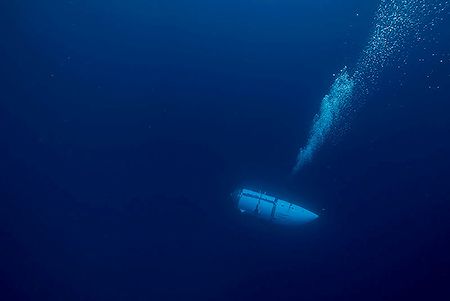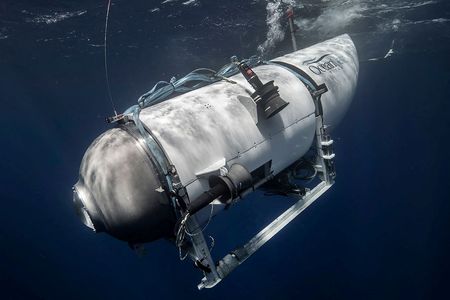By Joseph Ax and Brendan O’Brien
(Reuters) – Canadian aircraft detected underwater noises in the North Atlantic in the search for a tourist submersible that vanished while on a voyage to the wreck of the Titanic , the U.S. Coast Guard said.
The discovery on Tuesday led search teams to relocate their underwater robotic search operations “in an attempt to explore the origin of the noises,” the Coast Guard said in a series of tweets early on Wednesday.
The newly relocated searches by ROV (remotely operated vehicles) came up empty handed but will continue, the Coast Guard said.
The Coast Guard did not detail the nature or extent of the sounds that were detected, or how they were picked up.
But CNN and Rolling Stone magazine, citing internal U.S. government communications, independently reported late Tuesday that banging sounds were detected by Canadian aircraft at 30-minute intervals in the search area.
Rolling Stone, the first to report the news, said the sounds were detected by sonar buoys deployed in the area “close to the distress position” and that additional sonar picked up more banging four hours later.
CNN cited a U.S. government memo also as saying that additional sounds were heard about four hours after initial banging were detected, although the news channel said the second occurrence of noise was not described as banging.
“Additional acoustic feedback was heard and will assist in vectoring surface assets and also indicating continued hope of survivors,” CNN quoted the updated government memo as saying.
It was not immediately clear if the news reports were based on the same source.
The Titan, operated by U.S.-based OceanGate Expeditions, was built to stay underwater for 96 hours, according to its specifications – giving the five people aboard until Thursday morning before air runs out.
One pilot and four passengers were inside the miniature sub early on Sunday when it lost communication with a parent ship on the surface about an hour and 45 minutes into its two-hour dive.
SEARCH ZONE AS BIG AS CONNECTICUT
The wreck of the Titanic, a British ocean liner that struck an iceberg and sank on its maiden voyage in April 1912, lies about 900 miles (1,450 km) east of Cape Cod, Massachusetts, and 400 miles (644 km) south of St. John’s, Newfoundland.
U.S. and Canadian aircraft have searched more than 7,600 square miles of open sea, an area larger than the state of Connecticut, U.S. Coast Guard Captain Jamie Frederick told reporters at a press conference on Tuesday.
A commercial vessel with a remote-controlled deepwater submersible was also searching near the site, Frederick said.
Separately, a French research ship carrying its own deep-sea diving robot vessel was dispatched to the search area at the request of the U.S. Navy and was expected to arrive Wednesday night local time, the Ifremer research institute said.
Those aboard Titan for a tourist expedition that costs $250,000 per person included British billionaire Hamish Harding, 58, and Pakistani-born businessman Shahzada Dawood, 48, with his 19-year-old son Suleman, who are both British citizens.
French explorer Paul-Henri Nargeolet, 77, and Stockton Rush, founder and CEO of OceanGate Expeditions, were also reported to be on board. Authorities have not confirmed the identity of any passenger.
Rescuers face significant obstacles both in finding the Titan and in saving the people aboard, according to experts.
In the event of a mid-dive emergency, the pilot would likely have released weights to float back to the surface, according to Alistair Greig, a marine engineering professor at University College London. But absent communication, locating a van-sized submersible in the vast Atlantic could prove challenging, he said.
The submersible is sealed with bolts from the outside, preventing the occupants from escaping without assistance even if it surfaces.
If the Titan is on the ocean floor, a rescue effort would be even more challenging due to the extreme conditions more than 2 miles beneath the surface. The Titanic lies 12,500 feet (3,810 meters) underwater, where no sunlight penetrates. Only specialized equipment can reach such depths without being crushed by the massive water pressure.
“I think if it’s on the seabed, there are so few submarines that are capable of going that deep. And so, therefore, I think it was going to be almost impossible to effect a sub-to-sub rescue,” said Tim Matlin, a Titanic expert.
U.S. President Joe Biden was “watching events closely,” White House national security adviser John Kirby said on Tuesday.
OceanGate said it was “mobilizing all options,” and U.S. Coast Guard Rear Admiral John Mauger told NBC News the company was helping to guide the search efforts.
The sinking of the Titanic, which killed more than 1,500 people, has been immortalized in books and films, including the 1997 blockbuster movie “Titanic,” which renewed popular interest in the wreck.
(Reporting by Joseph Ax and Brendan O’Brien; Additional reporting by Natalie Thomas, Aiden Nulty, Kanishka Singh, Ismail Shakil, Steve Scherer, Steve Holland, Daniel Trotta, Ariba Shahid and Steve Gorman; Editing by Edmund Blair, Janet Lawrence, Nick Zieminski, Sonali Paul and Raju Gopalakrishnan)









